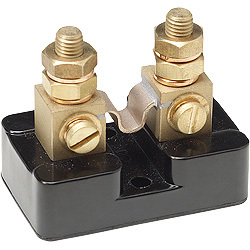- FEATURED PRODUCTS
- Solar Panels
- Solar Power Systems
- Productos Solares en Puerto Rico
- Charge Controllers
- Inverters
- Deep Cycle Batteries
- Solar Panel Mounts
- MORE PRODUCTS
- Cables & Wiring
- Enclosures, Electrical & Safety
- Inverter Power Panels & PreWired Systems
- Meters, Communications & Site Analysis
- Portable Power Systems
- Solar Water Pumps
- Voltage Converters
- Wind Turbines
- Books & Education
- * Clearance Sale *
- Hot Deals
- Open Box & Refurb Deals
100A, 100mV DC Shunt for Current Monitoring Meters
| Item code | Brand name | Model number |
| GENSHNT100/100 | Bogart Engineering | SH100 |
Bogart Engineering
TRI-METRIC SHUNTS
100A/100MV
![shunt]() Specifications
Specifications
- Resistance: "100 Amp at 100 millivolts" or 1.0 milliohm
- Max. steady state current, amps: 75 Amps
- Thermal time constant: 30 seconds
- Overload current: If normally operated at less than 50 amps, it will take overloads to 100 amps for durations of up
to 8 seconds. - Physical characteristics: Has plastic base 2.00 x 1.25 inches, with two mounting holes .205 "dia, .875 apart o.c.
Overall height 1.7 inches. High current connections are made to two bolts (1/4"-28) which are 1.00" apart.
How a shunt works
A shunt is necessary in order to measure amps and amp-hours with the TriMetric battery monitor. A shunt is an accurate, very low resistance resistor which is placed "in line" with the wire carrying the current to be measured. With the TriMetric, it is usually placed in the negative wire from the battery bank, such that all the current going into the battery (charging) or out (discharging) must pass through it. Connected in this way it will be set up to monitor "net" amp-hours in and out of the battery. (It also could be placed in series with the negative wire coming from a solar array--or other charging source--in which case it would measure only the solar array current, if that were desired--to show total solar "amp hours" production.) The shunt needs to be placed near the batteries; since these wires carry very high currents the wires from the batteries must be kept short to minimize electrical losses.
Shunt resistance
_250px-2.jpg)
Setting up the TriMetric for correct shunt
The TriMetric is designed to use either a 500 Amp/50 millivolt (0.1 milliohm) or 100 Amp/100 millivolt (1.0 milliohm) shunt. The latter shunt delivers 10 times the voltage for a given current flow through the shunt, so themeter can show an extra digit of current resolution (down to 0.01 amp) compared with the 500 Amp/50 millivolt shunt, which displays a minimum current of 0.1 amp. To make the TriMetric read "amps" and "amp-hours" correctly, you must tell the TriMetric which shunt is being used. This is done by programming either an "L" (low) or "H" (high) in one of the program modes. ("L" for the 100A/100 mV shunt, and "H" for the 500 A/50 mV shunt.) For how to do this refer to TriMetric instructions under "How to set efficiency factor and shunt type".






 Specifications
Specifications
